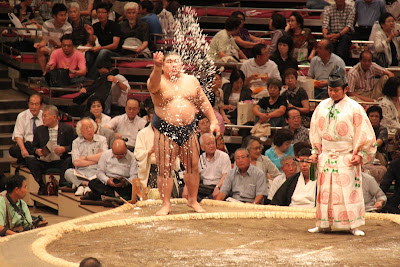
Sumo season actually came and went...but as how life goes here in Japan....all these months later, I just now have the time to post about it!

At the end of the summer Nick and I got to witness our first sumo match! On September 11, when most Americans were remembering the somber day in our history, we were watching sweaty Japanese men wrestle.


We went with two other couples and spent the afternoon watching an entire sumo tournament! (That's alot of sumo!!!)

We stopped to grab a bite to eat just before the tournament, and sat next to two wrestlers doing the same thing (only they were beefing up for their upcoming event and we just wanted a snack and a beer).

Like at any other sporting event, be it in the States or Japan, there was a mascot dancing around and getting attention. (We skipped the line of fans waiting to get a photo, and opted for the side shot instead!)

Once inside the arena, we had to find our seats. We upgraded for the more expensive "box seats" instead of sitting in the nose-bleed section. They were in fact, "box seats"...the 6 of us were squished into 2 small boxes, sitting cross-legged on floor pillows! (These boxes were meant for 4 Japanese people, but we were told that it was too small for us Americans and that we out to not stick more than 3 people in each....which is what we did, and yet, it was still a bit cramped!)

Nick of course, did his research and was informing us of what and why was going on, like a commentator giving play by play...because the actual commentator was of course speaking in Japanese!
Due to his notes (and Wikipedia), I can inform you that:
Sumo originated in Japan, and it is the only country where it is practiced professionally.

The wrestling ring where the sumo match takes place is called a dohyo (accent over the o). A new dohyo is built for each tournament.

After mounting the dohyo, the wresters perform many rituals...
Facing the audience, each wrestler will clap his hands and then do a leg-stomping "shiko" exercise which is supposed to, "drive evil spirits from the dohyo". Shiko is "the sumo exercise where each leg in succession is lifted as high and as straight as possible, and then brought down to stomp on the ground with considerable force".
It was crazy to see these huge men who appear overweight and immobile, lifting their giant legs up with ease!!!
Then the wrestlers will step out of the ring and into their separate corners, where they will each be given a ladleful of water. (The water is called "chikara-mizu," meaning "power water.") With the chikara-mizu the wrestler will rinse out his mouth, then use a paper tissue (called "chikara-gami" or the "power paper") to dry his lips.
After this ritual, the wrestlers will step back into the ring, squat facing each other, clap their hands, then spread them wide...this is traditionally done to show they don't have any weapons! (thank goodness, or it could've gotten bloody!!!)

The men then return to their corners, pick up a handful of salt and toss it into the ring to purify it. (Yep, it's a lot of back and forth! Like I said, many rituals...that's the way of the Japanese!)

The object of sumo is to get one's opponent to step out of the ring, or to force him to touch the ground with any part of his body other than the bottom of his feet.

Each tournament begins on a Sunday and runs for 15 days, ending on a Sunday. We were there on the final Sunday.

Each day of the tournament is structured so the highest-ranked contestants compete at the end of the day.
Traditionally on the last day of the tournament (called "senshuraku") the final matchup is between the top two ranked wrestlers. The Emperor's Cup is presented to the wrestler who wins the top division championship.
Not surprisingly, this match was by far the most interesting to watch!
The Grand Champion wears the Yokozuna belt ("Yokozuna" literally means "horizontal rope") which is a white rope and ceremonial apron weighing 30 kg (66pds)!

 The entire event was fascinating....very different from the sporting events we are used to in the States. Definitely something we wanted to experience once...though seeing it again is most likely not in our future!
The entire event was fascinating....very different from the sporting events we are used to in the States. Definitely something we wanted to experience once...though seeing it again is most likely not in our future! 
One more cultural experience checked of the Holman's "to do while in Japan" list!








Looks fun!
ReplyDelete